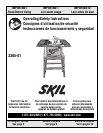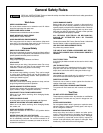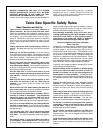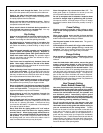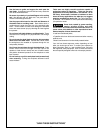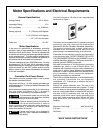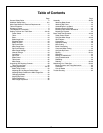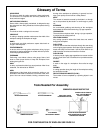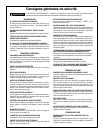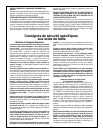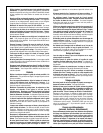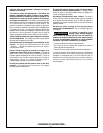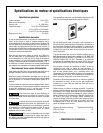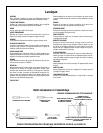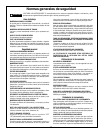
3.
Basic Operation and Set Up.
Table saws are intended to cut wood, wood like or
p
lastic materials. Do not cut metal with table saws.
Plastic and composition (like hardboard) materials may be
cut on your saw. However, since these are usually quite hard
and slippery, the anti-kickback pawls may not stop a
kickback. Therefore, be especially attentive to following
proper set-up and cutting procedures for ripping. Do not
stand, or permit anyone else to stand, in line with a potential
kickback.
Unplug saw before making adjustments, repairs or
storing.
Accidental start-ups can cause serious personal
injury.
Wear eye, ear and dust protection. Dust and particles
from cutting should not be inhaled. Eye protection can shield
your eyes if small pieces of wood or other objects are thrown
back during operation. Power tools are loud in operation,
protect your hearing with earplugs or muffs.
Do not wear such items as loose fitting gloves, loose
clothing, necktie, or jewelry. Tie back long hair and roll
long sleeves above elbows.
Loose clothing or jewelry can
be caught in rotating parts and you may be dragged into the
cutting element of the power tool.
Use the table saw in a well-lit area and on a level
surface, clean and smooth enough to reduce the risk of
trips and falls.
Cluttered work areas are accidents waiting
to happen.
Make sure the floor is clean and non-slippery or non-
skid where the table saw is set up. Wear non-slip
footwear.
If you cannot control your motion, you cannot
control the work.
Never turn the saw “ON” before clearing the table of all
tools, wood scraps, etc.,
except the workpiece and related
feed or support devices for the operation planned.
To avoid tipping your table saw in operation, BOLT it
securely to a stand or workbench. Long workpieces
need extra support on the outfeed side such as an
auxiliary support or roller stand.
Long and heavy pieces
may cause the table saw to tip over if not supported properly.
Don’t try to cut large sheets that you cannot guide with
the fence or miter gauge.
If you cannot see the tabletop
under the workpiece, the workpiece is too big for safe cutting
with the table saw.
Turn the table saw “OFF” and let the spinning blade
stop before attempting to remove cutoff or workpiece
from table.
You may inadvertently contact the coasting
blade.
Use common sense – if your set up doesn’t feel right or
is not complete – Don’t attempt the cut!
Complete the set
up using clamps, feather boards, push sticks, fence, miter
gauge, outfeed support, side support or whatever it takes to
keep the workpiece moving through the blade cleanly,
s
moothly and without making contact with you.
Stop operating immediately if any part of your saw is
missing, malfunctioning, has been damaged or broken
such as the motor switch, or other operating control, a
safety device or the power cord. Repair or replace the
particular part before operating the table saw again.
Causes and Operator Prevention of Kickback
with a Table Saw:
Kickbacks are caused by operator inattention and misuse of
the table saw (i.e. binding the blade, lack of guard, splitter,
kickback pawls or use of miter gauge with rip fence).
Kickbacks can cause serious injury. A “KICKBACK” occurs
when a part of the workpiece binds between the blade and
the rip fence or other fixed object. Workpiece binding the
blade due to misalignment can also cause kickback. During
kickback, workpiece rises from table and is thrown rapidly
back toward the operator. Keep your face and body to one
side of the blade, out of line with a possible “KICKBACK”.
In general, some simple procedures and setups can usually
avoid kickbacks and possible injury:
Adjust the blade so that it is parallel to the miter gauge
slots on the table then adjust the fence so that it is
parallel to the blade. Do not use miter gauge and rip
fence together in cutting operations.
A misaligned fence,
miter gauge or these two devices used together could cause
the workpiece to become like a wedge and bind the spinning
blade.
Always use the guard for every through cutting
operation.
The guard system (hood, splitter and anti-
kickback pawls) is designed to reduce the intensity of a
kickback and keep your hands away from the spinning
blade.
When using a push stick or block the trailing end of the
work must be square.
A push stick or block against an
uneven end can slip off or push the work away from fence.
Keep the saw blade clean and sharp. Dull and sticky
blades will increase the tendency to bind in the workpiece.
Do not trap or confine the cut-off piece when ripping or
crosscutting. Let the cut off piece be free to move away
from the blade.
Trapping the workpiece between the fence
and the blade will cause a kickback.
Do not position your hands or fingers in the path of the
blade.
You may slip into the blade if you apply uneven or
excessive force. You can be dragged back into the blade
during a kickback.
Push the workpiece through against the rotation of the
blade.
Never feed material from the back of the saw as the
blade can launch the workpiece at great velocity across the
tabletop.
Table Saw Specific Safety Rules
BEFORE CONNECTING THE TOOL TO A POWER
SOURCE (RECEPTACLE, OUTLET, ETC.), BE SURE
VOLTAGE SUPPLIED IS THE SAME AS THAT
SPECIFIED ON THE NAMEPLATE OF THE TOOL.
A power source with voltage greater than that specified for
the tool can result in serious injury to the user — as well as
damage to the tool. If in doubt, DO NOT PLUG IN THE
TOOL. Using a power source with voltage less than the
nameplate rating is harmful to the motor.



